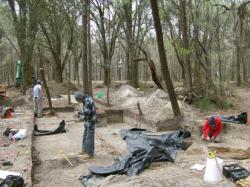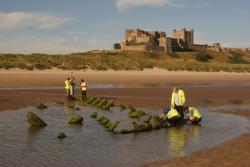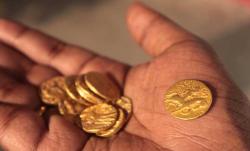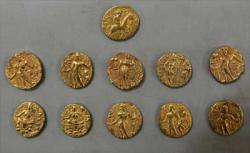INSTITUT SUPERIEUR D'ANTHROPOLOGIE
INSTITUTE OF ANTHROPOLOGY
ONLINE COURSES / COURS A DISTANCE
WINTER TERM : JANUARY 2014
REGISTER NOW
FRANCE –  Chef Boutonne- Sur décision du SRA (Service régional d'archéologie), des fouilles sont entreprises depuis le lundi 18 novembre dans une parcelle d'un terrain situé non loin du stade municipal et destiné à accueillir la nouvelle gendarmerie. Des sondages réalisés en mars ont certifié que l'endroit faisait bel et bien partie d'un vaste ensemble ayant été un cimetière mérovingien datant des VIe-VIIIe siècles. Il s'agit de vérifier si la prévision de la présence d'une quarantaine de sépultures était fondée. En charge de l'opération, la municipalité a confié le décapage des 700 m2 concernés à l'entreprise de Marc Legrand et l'intervention archéologique proprement dite à Archéosphère, une société de Bordeaux spécialisée dans l'exploration des sites paléolithiques et funéraires.Conduite par Cédric Beauval, une équipe de cinq fouilleurs s'est mise à l'œuvre sur une emprise de 280 m2. La première semaine du chantier a été consacrée à la mise au jour et à la délimitation d'éventuelles inhumations. Conformément à l'estimation initiale, pas moins de quarante sépultures ont affleuré au cours du décapage. Il s'agit maintenant et jusqu'au vendredi 13 décembre, dernier jour du chantier, d'observer, entre autres, la position des corps et leurs possibles déplacements. Il s'agit aussi de noter les renseignements obtenus, de faire des clichés photographiques et de prélever les restes osseux. Des analyses plus approfondies seront ensuite engagées dans un laboratoire apte à déterminer le sexe, l'âge, les caractères familiaux, les pathologies des sujets étudiés. Un rapport sera remis dans un an à la mairie et au SRA. Quant au mobilier, il sera déposé en un lieu adéquat et accessible aux chercheurs.
Chef Boutonne- Sur décision du SRA (Service régional d'archéologie), des fouilles sont entreprises depuis le lundi 18 novembre dans une parcelle d'un terrain situé non loin du stade municipal et destiné à accueillir la nouvelle gendarmerie. Des sondages réalisés en mars ont certifié que l'endroit faisait bel et bien partie d'un vaste ensemble ayant été un cimetière mérovingien datant des VIe-VIIIe siècles. Il s'agit de vérifier si la prévision de la présence d'une quarantaine de sépultures était fondée. En charge de l'opération, la municipalité a confié le décapage des 700 m2 concernés à l'entreprise de Marc Legrand et l'intervention archéologique proprement dite à Archéosphère, une société de Bordeaux spécialisée dans l'exploration des sites paléolithiques et funéraires.Conduite par Cédric Beauval, une équipe de cinq fouilleurs s'est mise à l'œuvre sur une emprise de 280 m2. La première semaine du chantier a été consacrée à la mise au jour et à la délimitation d'éventuelles inhumations. Conformément à l'estimation initiale, pas moins de quarante sépultures ont affleuré au cours du décapage. Il s'agit maintenant et jusqu'au vendredi 13 décembre, dernier jour du chantier, d'observer, entre autres, la position des corps et leurs possibles déplacements. Il s'agit aussi de noter les renseignements obtenus, de faire des clichés photographiques et de prélever les restes osseux. Des analyses plus approfondies seront ensuite engagées dans un laboratoire apte à déterminer le sexe, l'âge, les caractères familiaux, les pathologies des sujets étudiés. Un rapport sera remis dans un an à la mairie et au SRA. Quant au mobilier, il sera déposé en un lieu adéquat et accessible aux chercheurs.
http://www.lanouvellerepublique.fr/Deux-Sevres/Communes/Chef-Boutonne/n/Contenus/Articles/2013/11/30/Mise-au-jour-de-40-sepultures-merovingiennes-1706573
CHINE –  Shimao - Archaeologists in northwest China's Shaanxi Province said they had excavated over 80 skulls in the ruins of the largest neolithic Chinese city ever discovered. The skulls were found in groups and their limb bones could not be retrieved elsewhere at the Shimao Ruins in Shenmu County, Yulin City, said Sun Zhouyong, deputy head of the Shaanxi Provincial Institute of Archaeology, on Sunday. Two groups of skulls were firstly found in two pits, with 24 of the grisly finds in each, in front of the east gate of the city ruin while others were later uncovered along the eastern city wall, Sun said. Archaeologists deduced that these skulls are likely to be related to the construction of the city wall, suggesting that ancient religious activities or foundation ceremonies were launched before construction of the neolithic city began. Sun said anthropologists identified most of the skulls as belonging to young women, which suggested the outbreak of mass violence or ethnic conflict in the region since ancient people were prone to use their enemies or captives as sacrifices. These skulls will serve as important materials for research on the religious thinking, construction concepts and cultural activities of people living along the Yellow River Basin over 4,000 years ago, according to Sun.The Shimao Ruins were first found in 1976 in the form of a small town, and archaeological authorities identified the ruins as the largest of their kind from neolithic times in 2012 after measuring the exact size of the ancient stone city. Archaeologists said the city was built about 4,300 years ago and was abandoned roughly 300 years later during the Xia Dynasty (2100-1600 BC), the first dynasty in China to be described in ancient historical chronicles.
Shimao - Archaeologists in northwest China's Shaanxi Province said they had excavated over 80 skulls in the ruins of the largest neolithic Chinese city ever discovered. The skulls were found in groups and their limb bones could not be retrieved elsewhere at the Shimao Ruins in Shenmu County, Yulin City, said Sun Zhouyong, deputy head of the Shaanxi Provincial Institute of Archaeology, on Sunday. Two groups of skulls were firstly found in two pits, with 24 of the grisly finds in each, in front of the east gate of the city ruin while others were later uncovered along the eastern city wall, Sun said. Archaeologists deduced that these skulls are likely to be related to the construction of the city wall, suggesting that ancient religious activities or foundation ceremonies were launched before construction of the neolithic city began. Sun said anthropologists identified most of the skulls as belonging to young women, which suggested the outbreak of mass violence or ethnic conflict in the region since ancient people were prone to use their enemies or captives as sacrifices. These skulls will serve as important materials for research on the religious thinking, construction concepts and cultural activities of people living along the Yellow River Basin over 4,000 years ago, according to Sun.The Shimao Ruins were first found in 1976 in the form of a small town, and archaeological authorities identified the ruins as the largest of their kind from neolithic times in 2012 after measuring the exact size of the ancient stone city. Archaeologists said the city was built about 4,300 years ago and was abandoned roughly 300 years later during the Xia Dynasty (2100-1600 BC), the first dynasty in China to be described in ancient historical chronicles.
http://news.xinhuanet.com/english/china/2013-12/02/c_132934754.htm
Des archéologues en Chine ont exhumé les crânes de plus de 80 jeunes femmes qui pourraient avoir fait l'objet d'un sacrifice il y a plus de 4.000 ans, a rapporté lundi la presse d'Etat. Ces reliques ont été mises au jour dans les ruines de Shimao, un important site archéologique de l'époque néolithique, dans le nord du pays, a précisé l'agence de presse Chine nouvelle. Le reste du squelette des femmes n'a pas été retrouvé, ce qui conduit les experts à croire qu'elles ont été sacrifiées, vraisemblablement lors d'une cérémonie "liée à l'édification des murailles de la ville", selon l'agence. L'étude des échantillons osseux collectés lors des fouilles laisse penser que les femmes ont été assommées puis brûlées, a indiqué Sun Zhouyong, un responsable de l'institut d'archéologie de la province du Shaanxi. "Cet enterrement collectif pourrait être lié à la cérémonie fondatrice de la ville", a-t-il expliqué. Situées dans cette province septentrionale, les ruines de Shimao ont été découvertes en 1976, mais les archéologues n'ont réalisé que récemment qu'elles faisaient partie d'une ville bien plus étendue remontant à l'époque néolithique. L'existence de sacrifices a déjà été établie dans l'antiquité chinoise, des membres de l'aristocratie se faisant notamment inhumer avec leurs serviteurs et concubines.
http://www.leparisien.fr/flash-actualite-culture/des-archeologues-decouvrent-en-chine-des-cranes-de-femmes-sacrifiees-02-12-2013-3370031.php
USA –  Savannah - A Mexican coin punctured with a small hole, nails from long-decayed wooden dwellings, and broken bits of plates and bottles are among thousands of artifacts unearthed from what archaeologists suspect were once slave quarters at the site of a planned highway project in Savannah. A team hired to survey the site by the Georgia Department of Transportation spent three months excavating 20 acres of undeveloped woods tucked between a convenience store and apartments off busy Abercorn Extension on Savannah's suburban south side. Archaeologist Rita Elliott said the project yielded a staggering 33,858 artifacts believed to date from about 1750 until after the Civil War. Historical records show that a wealthy Savannah attorney named William Miller owned a large plantation at the site and at one time had 87 slaves, Elliott said. Archaeologists didn't find the main plantation house but believe many of the artifacts they found are consistent with slave dwellings.
Savannah - A Mexican coin punctured with a small hole, nails from long-decayed wooden dwellings, and broken bits of plates and bottles are among thousands of artifacts unearthed from what archaeologists suspect were once slave quarters at the site of a planned highway project in Savannah. A team hired to survey the site by the Georgia Department of Transportation spent three months excavating 20 acres of undeveloped woods tucked between a convenience store and apartments off busy Abercorn Extension on Savannah's suburban south side. Archaeologist Rita Elliott said the project yielded a staggering 33,858 artifacts believed to date from about 1750 until after the Civil War. Historical records show that a wealthy Savannah attorney named William Miller owned a large plantation at the site and at one time had 87 slaves, Elliott said. Archaeologists didn't find the main plantation house but believe many of the artifacts they found are consistent with slave dwellings.
http://www.deseretnews.com/article/765642588/Slave-artifacts-found-at-Ga-highway-project-site.html
ROYAUME UNI –  Bamburgh - Following the news that the partially-exposed shipwreck at Bamburgh is older than previously thought, a number of possible sources have been put forward. Earlier this month, we reported that survey work carried out by the Maritime Archaeology Sea Trust with help from local archaeologists and volunteers had revealed that the timber used was felled in or after 1768. It also established that the wood in the shipwreck, visible at low-tide on the beach below Bamburgh Castle, originates from the east of England, making the wreck British. Research by the creator of a blog – farne.co.uk – showed that there were severe storms in 1795, as well as December 1784 and November 1774. The 1795 storm reportedly wrecked at least six ships, including the brig Peggy, which was reported as sinking near Little Harcar, although her final position is unknown.
Bamburgh - Following the news that the partially-exposed shipwreck at Bamburgh is older than previously thought, a number of possible sources have been put forward. Earlier this month, we reported that survey work carried out by the Maritime Archaeology Sea Trust with help from local archaeologists and volunteers had revealed that the timber used was felled in or after 1768. It also established that the wood in the shipwreck, visible at low-tide on the beach below Bamburgh Castle, originates from the east of England, making the wreck British. Research by the creator of a blog – farne.co.uk – showed that there were severe storms in 1795, as well as December 1784 and November 1774. The 1795 storm reportedly wrecked at least six ships, including the brig Peggy, which was reported as sinking near Little Harcar, although her final position is unknown.
http://www.northumberlandgazette.co.uk/news/local-news/research-reveals-more-clues-to-wreck-1-6282039
INDE – 
 Ahiran - AT Unnao in Uttar Pradesh, a gold hunt proved futile as the Archaeological Survey of India (ASI) called off its digging that was started following a priest's claim that he had dreamt of a treasure beneath an old fort. Far away in West Bengal, even six months after a rare find from the Gupta era, the ASI is yet to act. Six months back, news channels flashed the discovery of 11 gold coins, thought to be belonging to the Gupta era (320 AD-550 AD), at Ahiran, 265 km from Murshidabad. The discovery made headlines in newspapers, but the ASI remained unaware of the fact.
Ahiran - AT Unnao in Uttar Pradesh, a gold hunt proved futile as the Archaeological Survey of India (ASI) called off its digging that was started following a priest's claim that he had dreamt of a treasure beneath an old fort. Far away in West Bengal, even six months after a rare find from the Gupta era, the ASI is yet to act. Six months back, news channels flashed the discovery of 11 gold coins, thought to be belonging to the Gupta era (320 AD-550 AD), at Ahiran, 265 km from Murshidabad. The discovery made headlines in newspapers, but the ASI remained unaware of the fact.
http://www.indianexpress.com/news/gupta-era-gold-coins-found-in-bengal--6-months-on-asi-yet-to-act/1202039/
ITALIE –  Pompéi - Un mur donnant sur l'une des principales rues de Pompéi s'est effondré après plusieurs semaines de pluie et de vent, ont annoncé lundi les responsables du site antique romain, qui tombe en décrépitude faute d'entretien. Du plâtre s'est également détaché d'un mur de la Maison de la petite fontaine. Les écroulements de murs se sont multipliés le mois dernier à Pompéi, ce qui a amené les médias italiens à parler de "novembre noir" pour cette ville antique restée ensevelie sous les cendres pendant de nombreux siècles après l'éruption du Vésuve en 79 de notre ère, avant d'être progressivement redécouverte à partir du XVIIIe siècle dans un état exceptionnel de conservation. Malgré les sommes débloquées notamment par l'Union européenne et un état d'urgence décrété en 2008, le site de Pompéi, classé au patrimoine mondial de l'Unesco, continue de se détériorer, ce qui alimente les accusations de détournements de fonds, de mauvaise gestion et d'intervention de la mafia.
Pompéi - Un mur donnant sur l'une des principales rues de Pompéi s'est effondré après plusieurs semaines de pluie et de vent, ont annoncé lundi les responsables du site antique romain, qui tombe en décrépitude faute d'entretien. Du plâtre s'est également détaché d'un mur de la Maison de la petite fontaine. Les écroulements de murs se sont multipliés le mois dernier à Pompéi, ce qui a amené les médias italiens à parler de "novembre noir" pour cette ville antique restée ensevelie sous les cendres pendant de nombreux siècles après l'éruption du Vésuve en 79 de notre ère, avant d'être progressivement redécouverte à partir du XVIIIe siècle dans un état exceptionnel de conservation. Malgré les sommes débloquées notamment par l'Union européenne et un état d'urgence décrété en 2008, le site de Pompéi, classé au patrimoine mondial de l'Unesco, continue de se détériorer, ce qui alimente les accusations de détournements de fonds, de mauvaise gestion et d'intervention de la mafia.
http://fr.news.yahoo.com/nouvel-effondrement-%C3%A0-pomp%C3%A9i-qui-tombe-en-d%C3%A9cr%C3%A9pitude-195045468.html